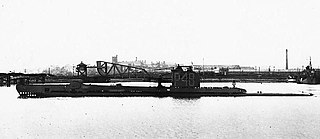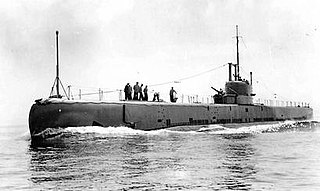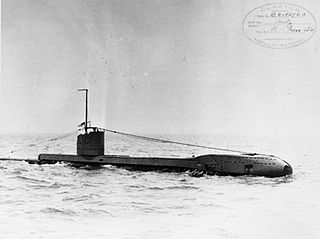
HMS Triton was a submarine of the Royal Navy named for the son of Poseidon and Amphitrite, the personification of the roaring waters. She was the lead ship of the T class of diesel-electric submarines. Her keel was laid down on 28 August 1936 by Vickers Armstrong at Barrow-in-Furness. She was launched on 5 October 1937, and commissioned on 9 November 1938.

HMS Ivanhoe was an I-class destroyer built for the Royal Navy in the mid-1930s. During the Spanish Civil War of 1936–1939, the ship enforced the arms blockade imposed by Britain and France on both sides as part of the Mediterranean Fleet. Before the start of World War II, the ship was modified so that she could be used to lay mines by removing some of her armament. Ivanhoe was transferred to Western Approaches Command shortly after the war began and helped to sink one German submarine in October 1939. She was converted to a minelayer while undergoing a refit in November–December and laid minefields in German coastal waters as well as anti-submarine minefields off the British coast until she was reconverted back to her destroyer configuration in February 1940. Ivanhoe reverted to her minelaying role during the Norwegian Campaign in April 1940 and then laid a number of minefields off the Dutch coast during the Battle of the Netherlands in May. The ship participated in the Dunkirk evacuation until she was badly damaged by German aircraft on 1 June. On her first minelaying mission after her repairs were completed, she struck a German mine and had to be scuttled on 1 September 1940 during the Texel Disaster.

HMS Hunter was a H-class destroyer built for the Royal Navy in the mid-1930s. During the Spanish Civil War of 1936–1939 the ship enforced the arms blockade imposed on both sides by Britain and France, until she struck a mine in May 1937. She was under repair for the next year and a half, after which she rejoined the Mediterranean Fleet. During the first few months of the Second World War, Hunter searched for German commerce raiders in the Atlantic Ocean until she was transferred back to Britain in February 1940. Returning to action in the Norwegian Campaign, she was sunk by German destroyers during the First Battle of Narvik in April 1940.
Operation Seagull was a British action during the Second World War to destroy several Nazi-controlled industrial targets including a smelter at Arendal, with the help of Kompani Linge agents from Norway.
At the outbreak of the Second World War Nazi Germany's Kriegsmarine had 21 destroyers in service, while another one was just being completed. These 22 vessels – comprising 3 classes – had all been built in the 1930s, making them modern vessels. Including that final pre-war vessel, a further 19 were brought into service during the war and more were captured from opposing navies, including the Italian Navy after the Italian Armistice with the Allies in 1943.

HNoMS Rauma was an Otra-class minesweeper built in 1939 for the Royal Norwegian Navy. Captured by the Germans during the 1940 invasion of Norway and renamed Kamerun, she was returned to the Norwegians after the end of the Second World War and recommissioned in 1947. Rauma remained in service until being sold for scrapping in 1963.

HNoMS Otra was an Otra-class minesweeper built in 1939 for the Royal Norwegian Navy. Captured by the Germans during the 1940 invasion of Norway and renamed Togo, she was returned to the Norwegians in 1946. Otra remained in service until being sold for scrapping in 1963.

HMS P48 was a Royal Navy U-class submarine built by Vickers-Armstrong at Barrow-in-Furness. Commissioned on 18 June 1942, she spent most of her career in the Mediterranean Sea.

HMS Oxley was an Odin-class submarine of the Royal Australian Navy (RAN) then Royal Navy (RN). Very slightly off course, near Obrestad, on the south-western cape of Norway, she was hit by friendly fire seven days after the start of World War II costing 53 lives and leaving two survivors.

HMS Sunfish was a Royal Navy S-class submarine which was launched on 30 September 1936 and served in the Second World War. Sunfish is one of 12 boats named in the song Twelve Little S-Boats.

HMS Thames (N71) was an ocean-going type of submarine of the River Class. She was built by Vickers Armstrong, Barrow and launched on 26 February 1932. She was completed on 14 September 1932, and after commissioning was assigned to the Mediterranean, stationed at Malta.

HMS Narwhal (N45) was one of the six ship class of Grampus-class mine-laying submarine of the Royal Navy. She was built by Vickers Armstrong, Barrow and launched 29 August 1935. She served in the Second World War in home waters. She was lost in the North Sea on 23 July 1940, probably sunk by German aircraft.

HMS Thistle (N24) was a T-class submarine of the Royal Navy. She was laid down by Vickers Armstrong, Barrow and launched in October 1938. She was sunk by the German submarine U-4 on 10 April 1940 near Skudenes.

HMS Unity was a U-class submarine, of the first group of that class constructed for the Royal Navy. The submarine entered service in 1938 and performed war patrols during the Second World War. On 29 April 1940, Unity was accidentally rammed and sunk in Blyth, Northumberland's harbour.

HNoMS Ula, previously HMS Varne, a British-built U-class submarine, and a member of the third group of that class to be built. She never actually served under the name Varne, being transferred before commissioning to the exiled Royal Norwegian Navy as HNoMS Ula (S300). In 1944 she sank a German U-boat during one of her patrols off Norway. She remained in Norwegian service and was scrapped in 1965.

HNoMS Tyr was a mine control vessel used for underwater search and recovery by the Royal Norwegian Navy. It was decommissioned in 2014 and sold to private owners.
Dundee International Submarine Memorial commemorates the 296 sailors and commandos lost on operations from the submarine base at Dundee in Scotland, HMS Ambrose, during World War II.

O 13 was an O 12-class submarine of the Royal Netherlands Navy that saw service during World War II. She was built by the Koninklijke Maatschappij De Schelde of Vlissingen. She was one of many Dutch ships doing convoy duty during the Spanish Civil War. At the time of the German invasion of the Netherlands, O 13 was on patrol off the Dutch coast and was attacked by German planes on multiple occasions. After fleeing to England, the submarine was lost during a patrol on the North Sea.

Greif was the third of six Type 23 torpedo boats built for the German Navy. The boat made multiple non-intervention patrols during the Spanish Civil War in the late 1930s. During World War II, she played a minor role in the Norwegian Campaign of 1940 by transporting troops that captured Arendal. Greif spent the next couple of years escorting minelayers as they laid minefields and laying minefields herself. She also spent the latter half of 1941 escorting convoys through the Skagerrak. The boat had a lengthy refit that lasted all of 1942 and then spent March–April 1943 escorting ships in Norwegian waters before returning to France. While deployed there Greif laid numerous minefields and escorted U-boats through the Bay of Biscay. The boat was sunk by Allied aircraft in May 1944.

Kondor was the fifth of six Type 23 torpedo boats built for the German Navy. The boat made multiple non-intervention patrols during the Spanish Civil War in the late 1930s. During World War II, she played a minor role in the attack on Oslo, the capital of Norway, during the Norwegian Campaign of 1940. Kondor spent the next several months escorting minelayers as they laid minefields and damaged heavy ships back to Germany before she was transferred to France around September. She started laying minefields herself that month and continued to do so for the rest of the war. The boat returned to France in 1942 and helped to escort blockade runners, commerce raiders and submarines through the English Channel and the Bay of Biscay. Damaged by a mine shortly before the Allied Invasion of Normandy in June 1944, Kondor was under repair on the day of the landings. Recognizing that she could not be repaired quickly, the boat was decommissioned later that month and was then further damaged by British bombers so that she was declared a constructive total loss.















